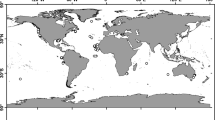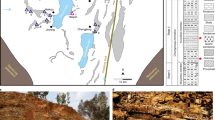Abstract
Late Cretaceous sediments from the Western Interior of North America yield exceptionally well preserved fossils1,2 that serve as proxies for the rapidly changing climate preceding the Cretaceous/Tertiary boundary (about 67–65 Myr ago)3,4. Here we reconstruct the ontogenetic history of a Maastrichtian-age fish, Vorhisia vulpes5, by using the carbon, oxygen and strontium isotope ratios of four aragonite otoliths collected from the Fox Hills Formation of South Dakota. Individuals of V. vulpes spawned in brackish water (about 70–80% seawater) and during their first year migrated to open marine waters of the Western Interior Seaway, where they remained for 3 years before returning to the estuary, presumably to spawn and die. The mean δ18O from the marine growth phase of V. vulpes yields a seawater temperature of 18 °C, which is consistent with leaf physiognomy and general-circulation-model temperature estimates for the Western Interior during the latest Maastrichtian4,6,7.
This is a preview of subscription content, access via your institution
Access options
Subscribe to this journal
Receive 51 print issues and online access
$199.00 per year
only $3.90 per issue
Buy this article
- Purchase on Springer Link
- Instant access to full article PDF
Prices may be subject to local taxes which are calculated during checkout


Similar content being viewed by others
References
Carpenter, S. J., Erickson, J. M., Lohmann, K. C. & Owen, M. R. Diagenesis of fossiliferous concretions from the Upper Cretaceous Fox Hills Formation, North Dakota. J. Sedim. Petrol. 58, 706–723 (1988)
McArthur, J. M., Kennedy, W. J., Chen, M., Thirlwall, M. F. & Gale, A. S. Strontium isotope stratigraphy for Late Cretaceous time: direct numerical calibration of the Sr isotope curve based on the US Western Interior. Palaeogeogr. Palaeoclimatol. Palaeoecol. 108, 95–119 (1994)
Barrera, E. & Savin, S. in Evolution of the Cretaceous Ocean–Climate System (eds Barrera, E. & Johnson, C. C.) 245–282 (Geol. Soc. Am. Spec. Pap. 332, 1999)
Wilf, P., Johnson, K. R. & Huber, B. T. Correlated terrestrial and marine evidence for global climate changes before the mass extinction at the Cretaceous–Paleogene boundary. Proc. Natl Acad. Sci. USA 100, 599–604 (2003)
Frizzell, D. L. Otoliths of new fish (Vorhisia vulpes, N. Gen., N. Sp. Siluroidei?) from Upper Cretaceous of South Dakota. Copeia 2, 178–181 (1965)
Wolfe, J. A. & Upchurch, G. R. Jr North American nonmarine climates and vegetation during the Late Cretaceous. Palaeogeogr. Palaeoclimatol. Palaeoecol. 61, 33–77 (1987)
Barron, E. J., Fawcett, P. J., Pollard, D. & Thompson, S. Model simulations of Cretaceous climates: the role of geography and carbon dioxide. Phil. Trans. R. Soc. Lond. B 341, 307–315 (1993)
Patterson, W. P., Smith, G. R. & Lohmann, K. C. in Continental Climate Change from Isotopic Indicators (eds Swart, P., Lohmann, K. C., McKenzie, J. & Savin, S.) 191–202 (Am. Geophys. Un. Monogr., 1993)
Thorrold, S. R., Campana, S. E., Jones, C. M. & Swart, P. K. Factors determining δ13C and δ18O fractionation in aragonitic otoliths of marine fish. Geochim. Cosmochim. Acta 61, 2909–2919 (1997)
Wurster, C. M. & Patterson, W. P. Late Holocene climate change for the eastern interior United States: evidence from high-resolution δ18O values of sagittal otoliths. Palaeogeogr. Palaeoclimat. Palaeoecol. 170, 81–100 (2001)
Ivany, L. C., Patterson, W. P. & Lohmann, K. C. Increase in seasonality across the Eocene–Oligocene boundary inferred from high-resolution microsampling of fossil otoliths, US Gulf Coastal Plain. Nature 407, 887–890 (2000)
Andrus, C. F. T., Crowe, D. E., Sandweiss, D. H., Reitz, E. J. & Romanek, C. S. Otolith δ18O record of Mid-Holocene sea surface temperatures in Peru. Science 295, 1508–1511 (2002)
Patterson, W. P. Oldest isotopically characterized fish otoliths provide insight to Jurassic continental climate of Europe. Geology 27, 199–202 (1999)
Waage, K. M. The Type Fox Hills Formation, Cretaceous (Maestrichtian), South Dakota, Part 1. Stratigraphy and Paleoenvironments (Peabody Museum of Natural History, Yale University, Bulletin 27, 1968).
Erickson, J. M. in Proc. F. D. Holland, Jr., Geol. Symp. (eds Erickson, J. M. & Hoganson, J. W.) 199–241 (North Dakota Geological Survey Miscellaneous Series no. 76, 1992)
Erickson, J. M. The Dakota Isthmus—closing the Late Cretaceous Western Interior Seaway. North Dakota Acad. Sci. Proc. 53, 124–129 (1999)
Carpenter, S. J., Erickson, J. M. & Hoganson, J. W. Isotopic characterization of the Late Cretaceous Fox Hills – Hell Creek Estuary of North and South Dakota. Geol. Soc. Am. Abstr. Program 31–32 (2002)
Nolf, D. & Stringer, G. L. in Mesozoic Fishes: Systematics and Paleoecology, Proc. Int. Meeting (eds Arratia, G. & Viohl, G.) 433–459 (Friedrich Pfeil, München, 1996)
Shackleton, N. J. & Kennett, J. P. Paleotemperature history of the Cenozoic and initiation of Antarctic glaciation: Oxygen and carbon isotope analyses in Deep Sea Drilling Project Sites 277, 279, and 281. Init. Rep. DSDP 74, 761–776 (1975)
Randall, R. G., Healy, M. C. & Dempson, J. B. in Common Strategies of Anadromous and Catadromous Fishes (eds Dadswell, M. J. et al.) 27–41 (American Fisheries Society, Bethesda, Maryland, 1987)
Healy, M. C. & Groot, C. in Common Strategies of Anadromous and Catadromous Fishes (eds Dadswell, M. J. et al.) 298–312 (American Fisheries Society, Bethesda, Maryland, 1987)
Peterson, B. J. & Fry, B. Stable isotopes in ecosystem studies. Annu. Rev. Ecol. Syst. 18, 293–320 (1987)
Schwarcz, H. P. et al. Stable carbon isotope variations in otoliths of Atlantic cod (Gadus morhua). Can. J. Aquat. Sci. 55, 1798–1806 (1998)
Weidman, C. R. & Millner, R. High-resolution stable isotope records from North Atlantic cod. Fisheries Res. 46, 327–342 (2000)
Wurster, C. M. & Patterson, W. P. Metabolic rate of late Holocene freshwater fish: evidence from δ13C values of otoliths. Paleobiology (in the press)
McCormick, S. D. & Saunders, R. L. in Common Strategies of Anadromous and Catadromous Fishes (eds Dadswell, M. J. et al.) 211–229 (American Fisheries Society, Bethesda, Maryland, 1987)
Ursin, E. in Symp. Zool. Soc. Lond. 44, 63–87 (1979).
Huddleston, R. W. & Savoie, K. M. Teleostean otoliths from the Late Cretaceous (Maestrichtian age) Severn Formation of Maryland. Proc. Biol. Soc. Wash. 96, 658–663 (1983)
Dettman, D. L. & Lohmann, K. C. Oxygen isotope evidence for high-altitude snow in the Laramide Rocky Mountains of North America during the Late Cretaceous and Paleogene. Geology 28, 243–246 (2000)
Acknowledgements
We thank G. Ludvigson, L. Gonzalez, T. White, H. Schwarcz and W. Patterson for comments on preliminary drafts of the manuscript, and N. Miller for strontium isotope analyses of biogenic carbonates.
Author information
Authors and Affiliations
Corresponding author
Ethics declarations
Competing interests
The authors declare that they have no competing financial interests.
Supplementary information
Rights and permissions
About this article
Cite this article
Carpenter, S., Erickson, J. & Holland, F. Migration of a Late Cretaceous fish. Nature 423, 70–74 (2003). https://doi.org/10.1038/nature01575
Received:
Accepted:
Issue Date:
DOI: https://doi.org/10.1038/nature01575
This article is cited by
-
The Evolution of the Age of Onset of Resistance to Infectious Disease
Bulletin of Mathematical Biology (2023)
-
Fish as proxies of ecological and environmental change
Reviews in Fish Biology and Fisheries (2016)
-
Dietary histories of herbivorous loricariid catfishes: evidence from δ13C values of otoliths
Environmental Biology of Fishes (2006)
Comments
By submitting a comment you agree to abide by our Terms and Community Guidelines. If you find something abusive or that does not comply with our terms or guidelines please flag it as inappropriate.



